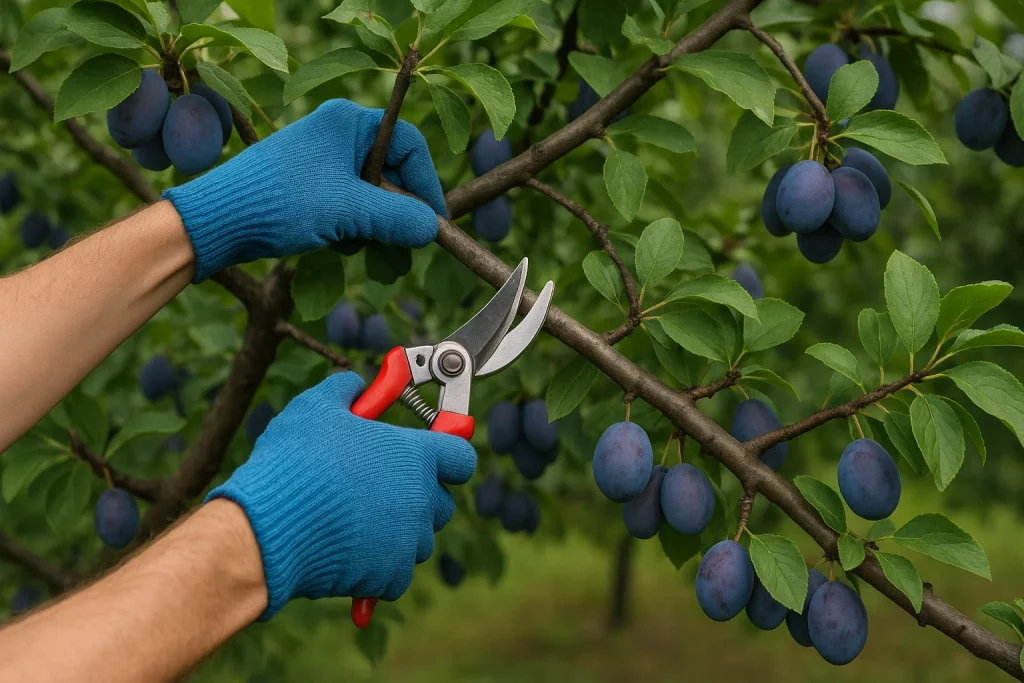The best time to prune plum trees in UK is late spring to early summer, typically between May and July. This timing promotes rapid healing, reduces the risk of diseases like Silver Leaf, and supports healthy growth for abundant fruit harvests.
Plum trees thrive when pruned at the right moment, and this guide will explain everything you need to know. We’ll cover why timing matters, the best pruning months, advice for different types of plum trees, and techniques to ensure your tree stays productive and healthy. If you’re in the Northampton area, Northampton Tree Surgeon is here to help with all your plum tree care needs.
Why Timing is Everything for Plum Tree Pruning
Pruning plum trees at the wrong time can lead to significant issues that undermine their health and productivity. Here’s why timing is crucial:
1. Disease Prevention
Pruning during colder, wetter months, particularly winter, can expose your trees to harmful diseases. Silver Leaf disease, for example, is a fungal infection that spreads easily when spores enter fresh pruning wounds. Late spring and early summer, when trees are actively growing, offer a safer window for pruning as healing occurs quickly, reducing vulnerability.
2. Sap Flow and Tree Healing
Pruning during the dormant winter period may result in excessive sap “bleeding.” Although plum trees do not tolerate winter pruning well, they handle cuts better during active growth when sap flow supports faster wound recovery.
3. Avoiding Frost Damage
Freshly cut wood is sensitive to frost damage. Late spring through early summer ensures that the risk of frost has passed, sparing your tree from unnecessary stress.
Correct timing helps maintain your tree’s natural defence mechanisms, ensuring long-term health and better fruit production.
The Best Time to Prune Plum Trees in the UK
The optimal window for pruning plum trees in the UK is between May and July. Here’s why this period works best:
- Rapid Healing: During late spring and early summer, the tree is fully active, which allows for quicker wound closure and healing, safeguarding against infections.
- Disease Risk is Lower: Warmer, drier weather minimises the risk of diseases, which thrive in cold, damp conditions.
- Enhanced Fruit Set: After the main fruit set, you can better assess which branches need pruning without affecting your harvest.
Benefits of Summer Pruning
Summer pruning isn’t just about disease control. It also helps to manage light and airflow within the canopy, contributing to better fruit development and reducing pest build-up. By thinning crowded branches, your tree can focus its energy on producing quality fruit.
Pruning Different Types of Plum Trees
Pruning requirements vary depending on the tree’s age, size, and condition. Here’s a breakdown of what to consider:
1. Pruning Young Plum Trees
Young plum trees need formative pruning to establish a desirable shape. This is typically done during their first few growing seasons:
- Focus on creating an open-centred structure by removing competing central shoots.
- Limit cuts to the late spring or early summer window to avoid harm.
2. Pruning Mature Plum Trees
For established trees, maintenance pruning ensures continued health and fruiting:
- Remove dead, diseased, or damaged wood every year during the recommended pruning window.
- Thin dense areas in the canopy to ensure even sunlight reaches the fruit.

3. Pruning Overgrown Plum Trees
Older, neglected trees may become overgrown. Renovative pruning is essential but must be approached gradually:
- Spread the process over two or more seasons to avoid stressing the tree.
- Focus first on removing dead or diseased branches before shaping the tree.
Plum Tree Pruning Schedule: A Seasonal Guide
To simplify plum tree care, follow this seasonal guide:
- Late Winter (Avoid for Plums):
- Do not prune during dormancy to prevent disease and frost damage.
- Spring (March – April):
- Inspect your tree and plan pruning during the late spring window. Avoid pruning frost-damaged wood until all risk of frost passes.
- Late Spring to Early Summer (May – July):
- Main pruning period. Remove any unwanted growth, dead wood, and thin the canopy for sunlight penetration.
- Autumn (September):
- Avoid autumn pruning as wounds heal more slowly with falling temperatures.
This schedule ensures you prune at the right time to maintain tree health and maximize fruit.
Beyond Timing: Key Pruning Techniques for Healthy Fruit
Timing is critical, but adopting the right techniques can amplify the benefits of pruning. Here are key methods to ensure your success:
- Remove Dead, Diseased, or Damaged Wood
- Use clean, sharp tools to cut back to healthy wood, promoting recovery and reducing disease spread.
- Thin Crowded Branches
- Clear out areas where branches overlap to improve airflow and sunlight, aiding fruit development.
- Shape for Yield
- Encourage an open structure that allows light to penetrate the canopy evenly.
Pruning is both an art and a science, and consistent, careful practice ensures your tree thrives year after year.
Conclusion
Pruning plum trees at the right time is essential for tree health and fruit production. The best window is late spring through early summer (May to July), as this helps avoid major diseases, supports rapid recovery, and boosts fruit yield. Whether managing a young sapling or rejuvenating an overgrown tree, proper timing and pruning techniques are key.
If you’re unsure or want professional help, contact Northampton Tree Surgeon. Our expert team is ready to care for your plum trees, ensuring beautiful, healthy growth and bountiful harvests. Get in touch today for tailored advice or our reliable pruning services!

